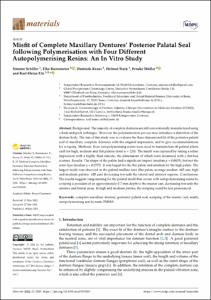Schiller, Simone; Rustemeier, Elke; Kraus, Dominik; Stark, Helmut; Müller, Frauke; Utz, Karl-Heinz: Misfit of Complete Maxillary Dentures’ Posterior Palatal Seal following Polymerisation with Four Different Autopolymerising Resins : An In Vitro Study. In: Materials. 2022, vol. 15, iss. 15, 1-13.
Online-Ausgabe in bonndoc: https://hdl.handle.net/20.500.11811/10754
Online-Ausgabe in bonndoc: https://hdl.handle.net/20.500.11811/10754
@article{handle:20.500.11811/10754,
author = {{Simone Schiller} and {Elke Rustemeier} and {Dominik Kraus} and {Helmut Stark} and {Frauke Müller} and {Karl-Heinz Utz}},
title = {Misfit of Complete Maxillary Dentures’ Posterior Palatal Seal following Polymerisation with Four Different Autopolymerising Resins : An In Vitro Study},
publisher = {MDPI},
year = 2022,
month = jul,
journal = {Materials},
volume = 2022, vol. 15,
number = iss. 15,
pages = 1--13,
note = {Background: The majority of complete dentures are still conventionally manufactured using a flask-and-pack technique. However, the polymerization process may introduce a distortion of the denture body. The aim of this study was to evaluate the three-dimensional fit of the posterior palatal seal of maxillary complete dentures with the original impression, and to give recommendations for scraping. Methods: Four autopolymerising resins were used to manufacture 40 palatal plates each for high, medium and flat palates (total n = 120). The misfit was captured by taking a reline impression with a highly fluid silicone, the dimensions of which were measured with a flat-bed scanner. Results: The shape of the palate had a significant impact (median p = 0.0435), but not the resin type (median p = 0.2575). It was largest for the flat palate and smallest for the high palate. The largest misfit was observed in the palatal midline area (flat-palate average median: 685 µm; high and medium palates: 620 µm) decreasing towards the lateral and anterior regions. Conclusions: The results suggest compensating for the palatal misfit that occurs with autopolymerising resins by scraping a postdam of an approximately 0.7 mm depth to the master cast, decreasing towards the anterior and lateral areas. In high and medium palates, the scraping could be less pronounced.},
url = {https://hdl.handle.net/20.500.11811/10754}
}
author = {{Simone Schiller} and {Elke Rustemeier} and {Dominik Kraus} and {Helmut Stark} and {Frauke Müller} and {Karl-Heinz Utz}},
title = {Misfit of Complete Maxillary Dentures’ Posterior Palatal Seal following Polymerisation with Four Different Autopolymerising Resins : An In Vitro Study},
publisher = {MDPI},
year = 2022,
month = jul,
journal = {Materials},
volume = 2022, vol. 15,
number = iss. 15,
pages = 1--13,
note = {Background: The majority of complete dentures are still conventionally manufactured using a flask-and-pack technique. However, the polymerization process may introduce a distortion of the denture body. The aim of this study was to evaluate the three-dimensional fit of the posterior palatal seal of maxillary complete dentures with the original impression, and to give recommendations for scraping. Methods: Four autopolymerising resins were used to manufacture 40 palatal plates each for high, medium and flat palates (total n = 120). The misfit was captured by taking a reline impression with a highly fluid silicone, the dimensions of which were measured with a flat-bed scanner. Results: The shape of the palate had a significant impact (median p = 0.0435), but not the resin type (median p = 0.2575). It was largest for the flat palate and smallest for the high palate. The largest misfit was observed in the palatal midline area (flat-palate average median: 685 µm; high and medium palates: 620 µm) decreasing towards the lateral and anterior regions. Conclusions: The results suggest compensating for the palatal misfit that occurs with autopolymerising resins by scraping a postdam of an approximately 0.7 mm depth to the master cast, decreasing towards the anterior and lateral areas. In high and medium palates, the scraping could be less pronounced.},
url = {https://hdl.handle.net/20.500.11811/10754}
}






